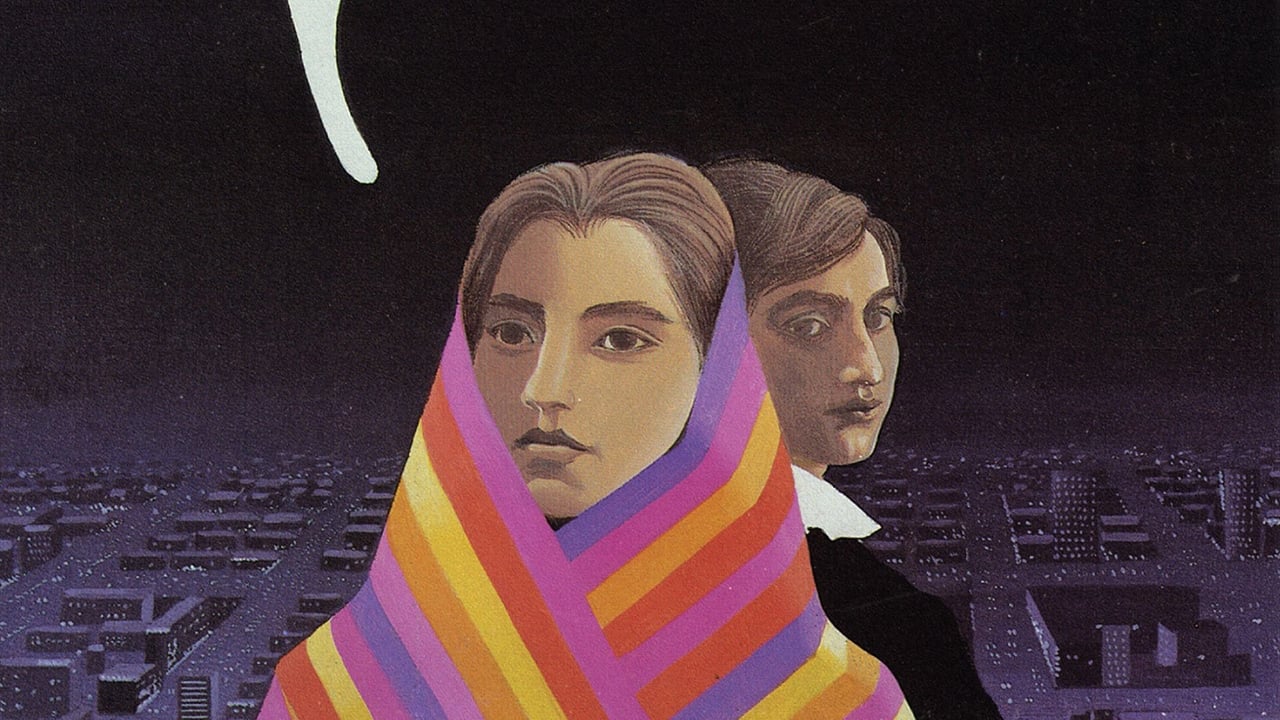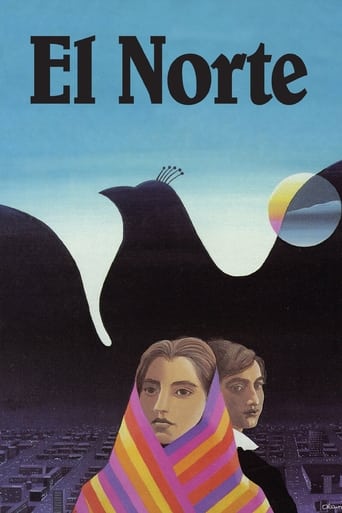gavin6942
Peasants escaping mindless labor and a murderous Guatemalan government head to America in hopes for something better.I am not super knowledgeable about immigration and I cannot say it is a topic I am very passionate about one way or the other. I don't think immigrants (legal or otherwise) should be demonized, but I certainly understand why we have a process in place so not everyone can come in.I think this film had a very realistic approach, and was more than just propaganda. We understand why the two main characters make the choices they do, and cannot be upset with them even if they are "illegal". We see the trouble they run into and the adjustments they make. I found it fascinating how the film explores the whole range from finding work, to the immigration authorities to getting medical care.
travelinggirl
A sweet wonderful film that really shows the life and plight of undocumented aliens. What motivates me to give it a 8 out of 10 is the ending part of the film and the lack of certain realistic aspects of the film and story. Aside from magic realism (a very popular genre in post-modernistic Latin American literature and film – see NOTE below), the characters of brother and sister have very few real hardships - in comparison with what Central Americans actually have to endure on their very difficult and torturous trip to the north. There are rapings, muggings, and of course, the most difficult and common entry point, the desert. The desert is such a huge aspect of the journey that needs to be overcome. If there had been more usage of the indigenous dialog – it would have been so much more truer to the experience of what these people went through.NOTE: For all you video game "fanboys" out there - here is the definition of "magic realism": A literary or artistic genre in which realistic narrative or technique are combined with surreal elements of dream or fantasy.
romanorum1
In the first part of this moving film, a macaw caws in Guatemala, signaling a treacherous act. In the last part, in the USA, a parrot squawks, signaling another betrayal. In Guatemala, a teen-aged Mayan girl washes clothes by hand and lays them out on the grass to dry out in the sun. Later she does the same task in the USA after being frustrated by a complicated washing machine's instructions. These are examples of the movie's effective repeated scenes. El Norte takes place during a difficult time in Guatemala – there is a civil war that will take the lives of 200,000 Indians.This motion picture is about two Mayan Indian teenagers – a brother and sister – who attempt to flee persecution in their native Guatemala to get to the promised land – "El Norte" (The North), the USA. Filmed with so much empathy for the two attractive teens, one wants to cheer for them to succeed somehow, even with the odds stacked against them. There are three main sections: I. Arturo Xuncax (Guatemala), II. El Coyote (Mexico), and III. El Norte (the USA). In Part I, life is pictured among native Indians in the colorful village of San Pedro. Families have dinner by candlelight; there is no electricity or plumbing. Each person has a different task. In the first scene, native Mayans from the village pick coffee beans under the watchful eye of an armed foreman. The foreman whips out his pistol and shoots into the air, signaling that the shift is over. Folks make some money but the hours are long and the work is backbreaking. Arturo and others in the village set up a secret meeting to form a protest, but he is treacherously betrayed and government troops surge into the village with the intention of killing any dissenters. Arturo Xuncax is among those killed; his head is hung from a tree. Later the troops return and take away Arturo's wife, Lupe (also to be liquidated). When Rosa, her daughter returns to their modest home, the place is inundated with white butterflies, signaling chaos (in Mayan folklore). After the loss of their parents and aware that their lives are in danger, Rosa and her brother Enrique decide to flee San Pedro and go to the USA via Mexico.In Part II the travails of the two Indian teens are manifested as they pretend to appear as Mexicans (who fiercely protect their border with Guatemala). "You have to learn to swear if you want to pass as Mexicans," they are told by a truck driver. Their naiveté and innocence are so obvious: Rosa and Enrique are devout Catholics and do not swear. But they are easy prey and fall under the spell of Mexican human smugglers ("coyotes"), who have dubious intentions. Bother and sister are caught by US customs agents, and are sent back across the border into Mexico. To pass as Mexicans instead of Guatemalans they had to fool the US customs agents by lying and swearing. One wishes that someone would have understood the situation and had advised them that they could have applied for USA citizenship as political dissenters through a customs process. Anyway Rosa, realizing that they will need to finance the border crossing, convinces Enrique that they will have to pawn her mother's valuable necklace (an heirloom that was made with gold and silver coin). After finally locating an "honest coyote," Rosa and Enrique make a harrowing escape under ground in an old drainage pipe/sewer (now blocked) that is infested with rats (undiseased laboratory rats were used for the scene).In Part III Rosa and Enrique are in the new land (Los Angeles). Monte, a Mexican-American who runs the aptly named Shady Acres Motel, shows them their new quarters, an absolutely disgusting and filthy motel apartment that at the least has electricity and plumbing. What a contrast to the simple but clean and colorful home that was left behind! Despite the difficult cultural and language barriers, the two protagonists remain undaunted and are determined to make the best of the circumstances. Every morning various vehicles pull into the motel parking lot to pick up illegal immigrants for assorted working assignments. Rosa gets a job as a stitcher in a clothing factory run by a Korean, and after a raid, changes work to be a home-keeper. She becomes friendly with Nacha, a nice Mexican woman, who knows a bit more about the new land. During lunch, Rosa notes that a busy LA street is packed with Mexicans, Central, and South Americans. "Where are the gringos," she asks. The answer, of course, is that they are in "their area" of the city. Meanwhile Enrique gets a very lucky break. He lands a decent position as a busboy in an upscale restaurant. His amiability and eagerness help him to move up the ladder. But Carlos, a Mexican-American employee who does not understand Spanish, is jealous and, as a "pocho," betrays him to the authorities. His parrot squawks. Enrique and a new friend barely escape a raid.Brother and sister clean up the apartment and take an evening course in English that is taught by a Japanese-American woman. While Rosa and Enrique have survived, and are not in danger of being killed for any political beliefs, they have no home and have no real support system. But Enrique has made such a good overall impression that Monte's American contacts have a great opening for him. In fact, he can obtain the ultimate prize, the green card, except that the opportunity lies in far away Chicago. Can Enrique really leave his sister alone? Soon Rosa is dying, both emotionally and of disease emanating from her previous contacts with the rats. In her hospital bed she whispers to her brother, "Enrique, we have no home." In the end there is Enrique, with "strong arms," digging a trench with a construction crew under the watchful eyes of a stern Mexican-American. He is now alone.
hbc1949
The oppression of immigrants is without question.....by coyotes, federals, etc. up to and including the employers in the USA who exploit the illegal immigrants who, for the most part, want little more than a chance to have a better life.The biggest issue for me with EL NORTE was the time line. In the time it takes Enrique and Rosa to learn English well enough to get work and such...and to converse in fairly idiomatic ways........her disease is --what?----waiting to erupt? The bites were not the same day as her fever, right? Also, the acting was wooden to the point of "community theater is better" especially on the part of the gringos---from the Border Patrol guys to the Chicago woman......And...would two Spanish speaking people talk to each other in English when communicating complex ideas such as best chance, green card, etc. as the scene at the motel with Enrique and the "arranger?" There are many good and great movies out there about the perils of immigration, oppression and so forth--and THIS one got the Oscar nomination? Again..a good concept.

